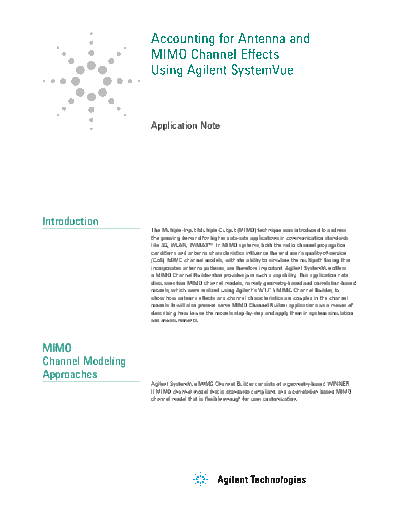Service Manuals, User Guides, Schematic Diagrams or docs for : HP Publikacje 5990-6535EN
<< Back | HomeMost service manuals and schematics are PDF files, so You will need Adobre Acrobat Reader to view : Acrobat Download Some of the files are DjVu format. Readers and resources available here : DjVu Resources
For the compressed files, most common are zip and rar. Please, extract files with Your favorite compression software ( WinZip, WinRAR ... ) before viewing. If a document has multiple parts, You should download all, before extracting.
Good luck. Repair on Your own risk. Make sure You know what You are doing.
Image preview - the first page of the document

>> Download 5990-6535EN documenatation <<
Text preview - extract from the document
Accounting for Antenna and
MIMO Channel Effects
Using Agilent SystemVue
Application Note
Introduction
The Multiple-Input-Multiple-Output (MIMO) technique was introduced to address
the growing demand for higher data-rate applications in communication standards
like 3G, WLAN, WiMAXTM. In MIMO systems, both the radio channel propagation
conditions and antenna characteristics influence the end user's quality-of-service
(QoS). MIMO channel models, with the ability to simulate the multipath fading that
incorporates antenna patterns, are therefore important. Agilent SystemVue offers
a MIMO Channel Builder that provides just such a capability. This application note
discusses two MIMO channel models, namely geometry-based and correlation-based
models, which were realized using Agilent's W1715 MIMO Channel Builder, to
show how antenna effects and channel characteristics are coupled in the channel
models. It will also present some MIMO Channel Builder applications as a means of
describing how to use the models step-by-step and apply them in system simulation
and measurements.
MIMO
Channel Modeling
Approaches
Agilent SystemVue MIMO Channel Builder consists of a geometry-based WINNER
II MIMO channel model that is standards compliant, and a correlation-based MIMO
channel model that is flexible enough for user customization.
Approach 1
The WINNER II channel model is a geometry-based stochastic model. [1] It also
Geometry-based Stochastic called a double directional channel model. The model does not explicitly specify the
Channel Modeling locations of the scatters, but rather the directions of the rays, like the well-known
Spatial Channel Model (SCM). [2] Both IMT-advances and consequently, LTE-
Advanced, apply this kind of model as the MIMO channel model for performance
tests. Geometry-based modeling of the radio channel enables separation of propaga-
tion parameters and antennas. The time variant impulse response matrix of the UxS
MIMO channel is given by
N
H (t ; ) = H n (t ; )
n =1
where t is time, is delay, N is the number of paths, and n is path index. The
impulse response matrix is composed of the antenna array response matrices Ftx and
Frx for the transmitter (Tx) and the receiver (Rx) respectively. The channel from the Tx
antenna element s to the Rx element u, for cluster n, is expressed as
Frx ,u ,V ( n,m ) n,m,VV n ,m,VH Ftx ,s ,V ( n ,m )
T
M
H u ,s ,n (t ; ) =
m =1 Frx ,u , H ( n , m ) n , m , HV
a n ,m , HH Ftx ,s , H ( n ,m )
( ) (
◦ Jabse Service Manual Search 2024 ◦ Jabse Pravopis ◦ onTap.bg ◦ Other service manual resources online : Fixya ◦ eServiceinfo